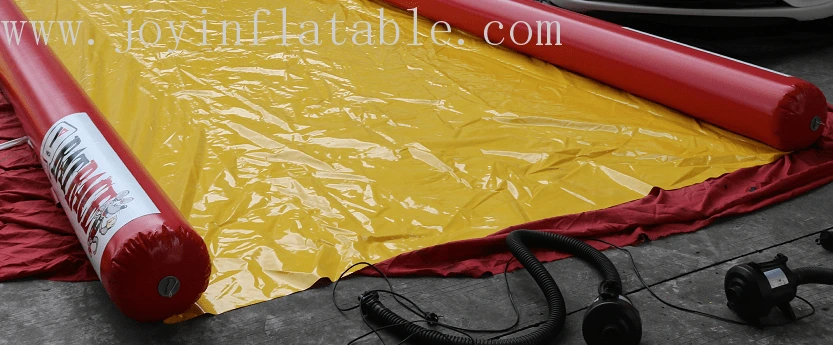Notifications

6 minutes, 50 seconds
-19 Views 0 Comments 0 Likes 0 Reviews

At first glance, a slip and slide might seem like just a summer toy meant for spontaneous fun and giggles. However, behind Joy Inflatable’s padded slip and slide for adults lies an intricate understanding of physics, material science, and safety engineering. Their design process is rooted in scientific principles that optimize performance, durability, and user safety. This combination ensures that the inflatable not only provides endless excitement but also upholds the highest standards of security and longevity. Exploring the science behind this product reveals how multiple disciplines come together to create an outdoor activity that is both thrilling and safe, making it a perfect example of innovation grounded in solid scientific research.
Material Science: The Backbone of Durability and Safety
The foundation of Joy Inflatable’s slip and slide is its choice of materials. The inflatable is primarily constructed from heavy-duty PVC, a material renowned for its strength, flexibility, and resistance to punctures. Advances in polymer science have produced PVC formulations that are lightweight yet incredibly resilient, capable of withstanding the constant friction and impact from adult sliding. The material’s molecular structure lends it elasticity, allowing it to stretch and absorb shocks without tearing apart. Additionally, it is treated with UV inhibitors, which slow down degradation caused by prolonged exposure to sunlight. This use of cutting-edge polymer technology guarantees the inflatable maintains its integrity over time, resisting the wear and tear that typically compromise cheaper alternatives.
Friction and Surface Texture: The Key to Speed and Safety
Friction plays a crucial role in how smoothly and safely an adult can slide down the inflatable. Joy Inflatable carefully designs the textured surface of their slip and slide to strike a perfect balance. The surface incorporates a slick coating that reduces surface friction, allowing for higher speeds and a more exhilarating experience, while the textured elements provide enough grip to prevent skin burns and burns caused by abrupt stops. Materials like polyethylene are combined with textured inserts that help control the slip rate, ensuring adults slide quickly without slipping uncontrollably or risking injury. This precise control of friction demonstrates a deep understanding of physics, illustrating how surface engineering enhances performance and safety simultaneously.
Impact Absorption and Padding: The Physics of Fall Prevention
Impact safety is a significant aspect of Joy Inflatable’s design, particularly concerning the padded zones at the landing areas. Scientific principles of energy absorption and impact distribution guide the placement and thickness of padding materials. Foam padding and cushioned barriers are strategically integrated to absorb the velocity and kinetic energy accumulated during sliding. When a user comes to a stop, this padding dissipates the energy across a broader area, reducing the force transferred to the body and decreasing injury risk. The padding’s density and resilience are calibrated through material testing to provide maximum shock absorption without compromising the inflatable’s overall flexibility and structural integrity. This focus on impact physics ensures that fun does not come at the expense of safety.
Hydrodynamics: Optimizing Water Flow for Speed and Safety
Water plays a vital role in creating the slick, speedy surface of Joy Inflatable’s slip and slide. The science of fluid dynamics explains how water flow reduces surface friction and increases slide velocity. The inflatable features adjustable nozzles that control water distribution across the surface, ensuring a consistent, thin layer that minimizes resistance. Proper water flow also prevents overheating of materials and reduces friction burns caused by dry slides. The water’s viscosity and flow rate are tuned to provide just enough lubrication for high-speed sliding while maintaining safety. This application of hydrodynamics results in a smooth, controlled descent, transforming basic physics into a fun and safe activity.

Structural Engineering: Ensuring Stability and Longevity
The design of a large inflatable slide must account for structural stability under varied and demanding conditions. Joy Inflatable employs principles of structural engineering to prevent deformation, tipping, or shifting during use. Reinforced seams, sturdy anchoring points, and weighted bases work together to distribute forces and maintain stability. The inflatable is tested under simulated stress conditions, such as high winds or multiple sliders, to verify that the structure maintains its shape and position. All these measures are based on understanding load distribution, material strength, and stress points, ensuring the inflatable can withstand continuous use over many seasons. This engineering approach guarantees not only safety but also durability, making it a reliable feature at any high-energy event.
A Synergy of Disciplines: Creating an Unforgettable Experience
What makes Joy Inflatable’s slip and slide truly innovative is the seamless integration of various scientific principles—material science, physics, fluid dynamics, and engineering—that come together to optimize performance and safety. Every aspect, from surface texture to impact padding to water flow control, is designed with precise scientific rationale. This interdisciplinary approach transforms a simple water slide into a carefully calibrated piece of entertainment technology that maximizes thrill while minimizing risk.

